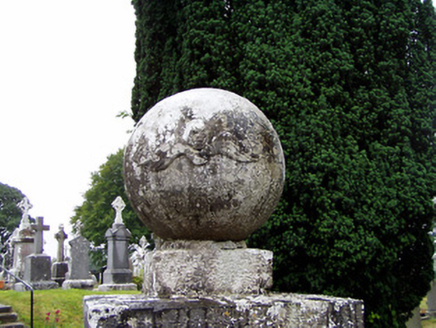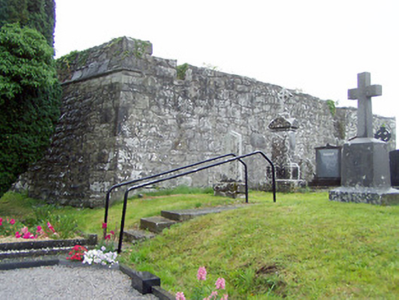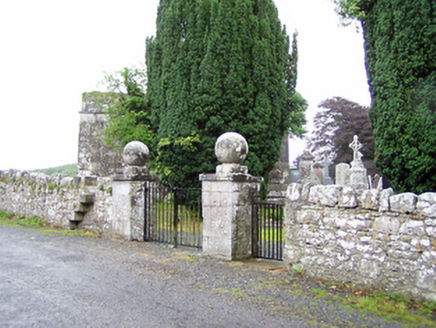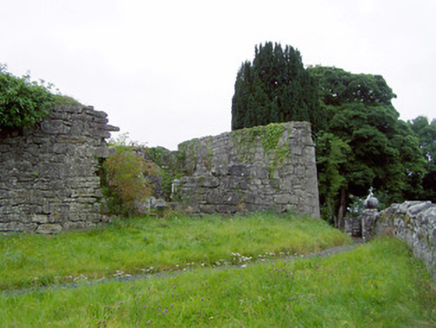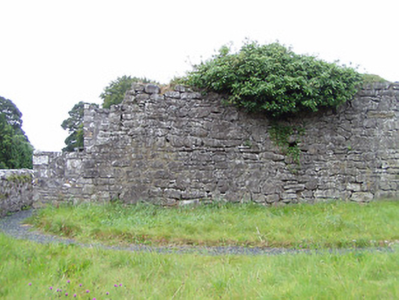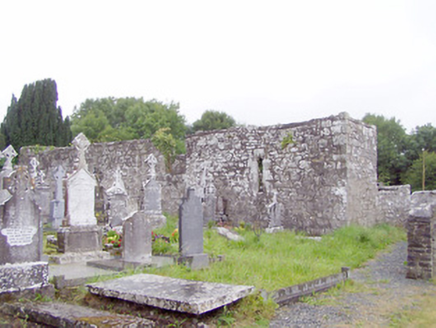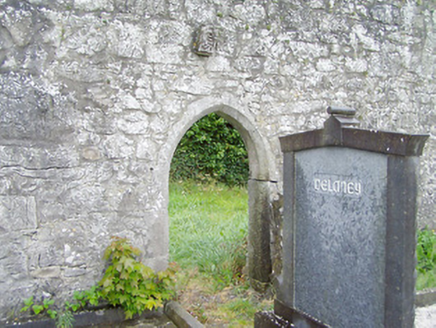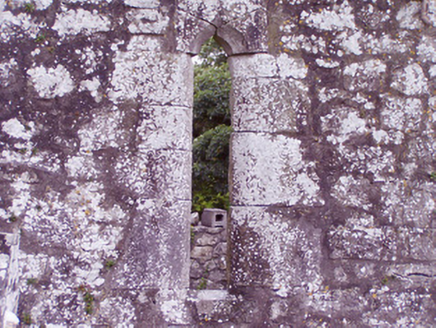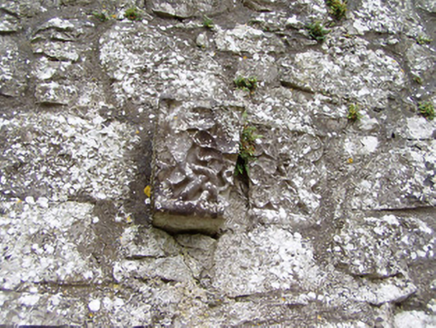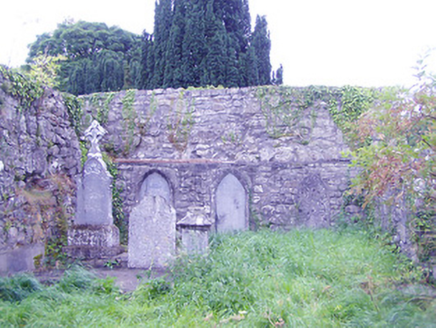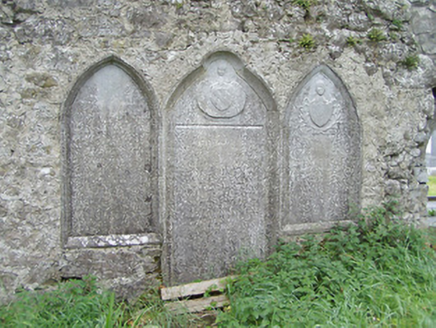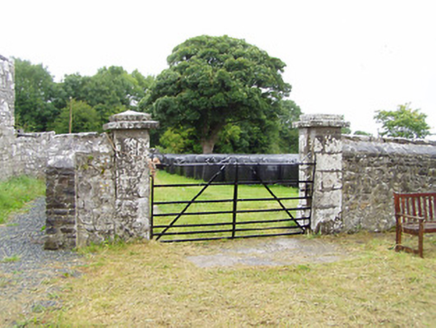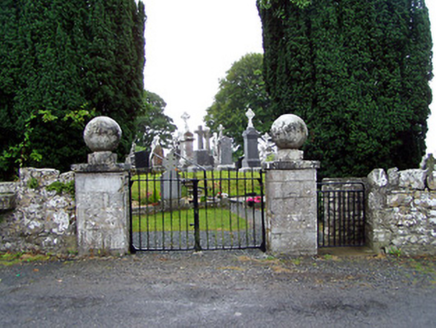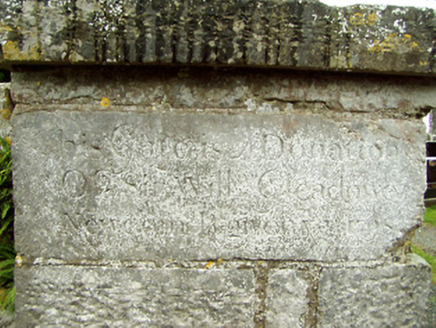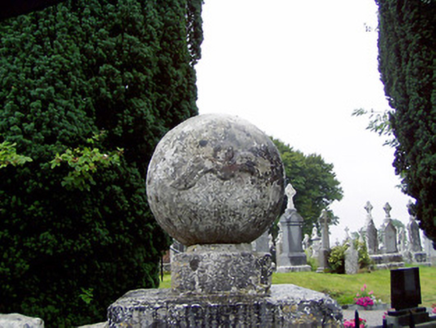Survey Data
Reg No
13402108
Rating
Regional
Categories of Special Interest
Architectural, Artistic, Historical, Social, Technical
Previous Name
Saint Catherine's Church (Cashel)
Original Use
Graveyard/cemetery
Historical Use
Graveyard/cemetery
In Use As
Gates/railings/walls
Date
1700 - 1800
Coordinates
201449, 260159
Date Recorded
04/08/2005
Date Updated
--/--/--
Description
Churchyard and graveyard on irregular oval-plan, erected c. 1730, containing remains of late medieval church (LF021-033001-). Graveyard contains collection of stone grave markers dating from the eighteenth to the twentieth century. Ruinous late medieval church (probably c. 1550) constructed of rubble limestone masonry (base batter to some elevations) having a Tudor-arched doorway with chamfered dressed limestone surround to the west end of the south elevation having cut stone floral devices over. Ogee-headed window opening with dressed limestone surround to the east end of the south elevation. Roof now missing. West end of church rebuilt with burial vaults inserted c. 1800. Graveyard surrounded by rubble limestone boundary walls having rubble stone coping over. Main entrance gateway to the north/northwest, dated 1798, comprising a pair of dressed ashlar limestone gate piers (on square-plan) having cut stone coping over surmounted by ball finials, and having wrought-iron double-gates. Carved seraphim motifs to ball finials. Incised lettering to ball finials, now illegible. Incised lettering to northeast pier reading ‘This gateway was donated by William Gleadowe Newcomen [not legible] 1798’. Pedestrian gateway to the southwest end of main gateway having modern gate. Gateway to the south/southeast of graveyard comprising a pair of dressed limestone gate piers (on square-plan) having stepped cut stone coping over and with a wrought-iron flat-bar gate having decorative wrought-iron detailing over. Located adjacent to small rural road, close to the shores of Lough Ree to the west, and sited to the west of Newtown-Cashel and to the south/southeast of Lanesborough.
Appraisal
This interesting site contains remains from a number of periods and is an important element of the built heritage and social history of the local area. The churchyard contains the remains of a late medieval church (LF021-033001-) and was the site of St. Catherine’s Church of Ireland church, which was built in 1816 (at a cost of £738) and was demolished at some stage over the last few decades. The graveyard contains an interesting and varied collection of cut stone grave markers (of recumbent, upstanding, box/table, and wall monuments), some of which are of high artistic merit. The earliest legible grave marker is dated 1725 and commemorates Daniel Murry. Of particular interest is the unusual main gateway. This gateway retains dressed limestone gate piers that are finely sculpted with ornate ball finials decorated with carved seraphim and engraved lettering. A plaque to one of the piers indicates that these piers were erected in 1798 by William Gleadowe Newcomen, who lived at Carrigglas Manor (13401414) to the northeast. The date of the erection of these piers suggests that they may have been erected to commemorate of celebrate the (failure) of the Rebellion of 1798. The level of craftsmanship involved in the construction of these gate piers is of the highest quality, and they serve as a reminder of the skill of local stonemasons and sculptors at the time of their construction. The gate piers provide important context to the locality and form an attractive roadside feature. The oval-shaped enclosure (LF021-033----) that surrounds the site suggests that there was an early medieval church/monastic foundation here, possibly associated with the extensive ecclesiastic site on Inchcleraun Island, which is located nearby on an island in Lough Ree to the west. The rubble stone boundary walls, the wrought-iron gates, and the secondary gateway to the south/southeast complete the setting of this interesting composition.
